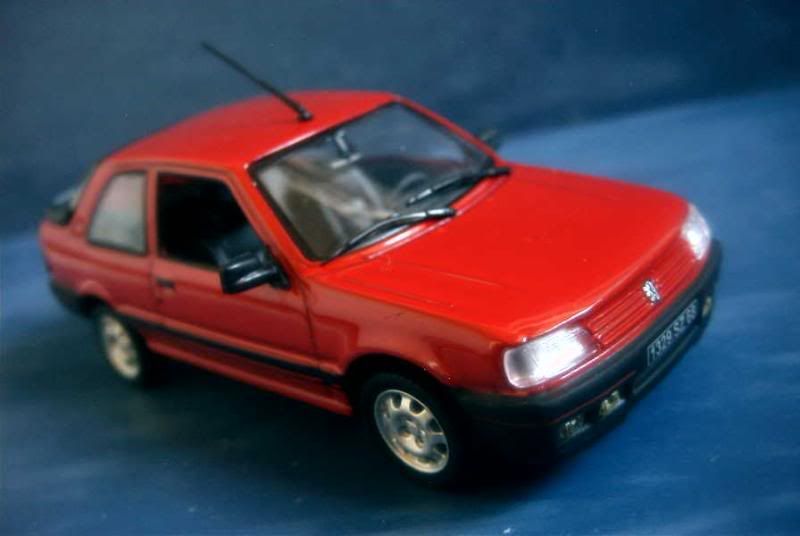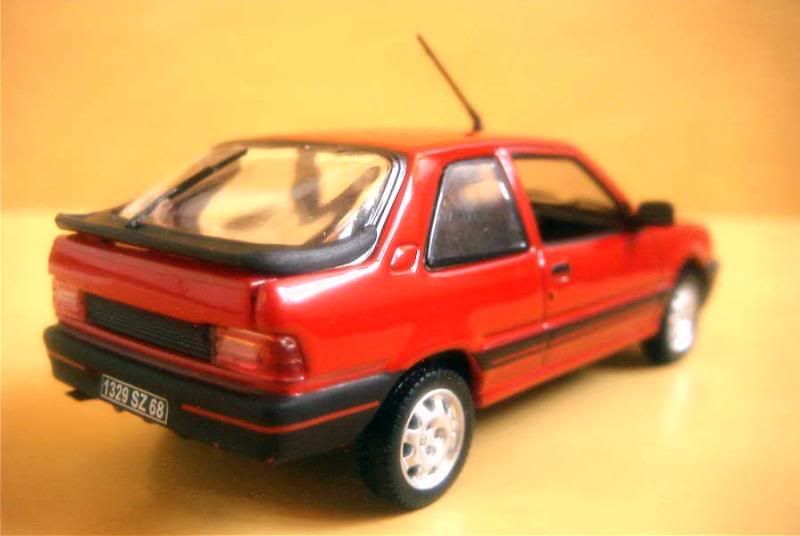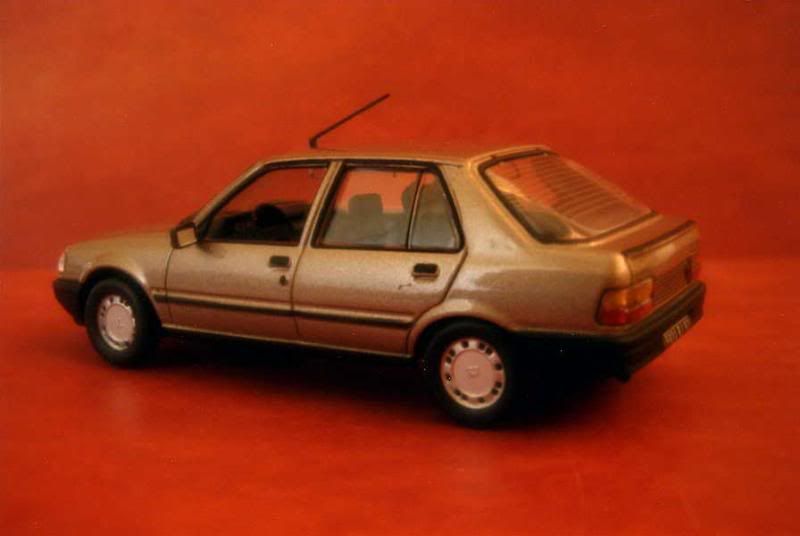A little history
At first sight, the Peugeot 309 could have appeared as a slightly larger variant of the successful 205. Actually, it wasn’t even intended to be part of the Peugeot range. After the takeover of all of Chrysler’s European operations by the PSA group, and the subsequent renaming of Simca to Talbot, plans were drawn regarding the replacement of the Horizon. The engineers at the Talbot plant in Poissy designed the Arizona for this purpose, basing their car on the Peugeot 205. Its passenger compartment was retained, but its front end was modified, while the all-new rear was lengthened. Indeed, this rear end was designed to cleared identify the car as a Talbot and, once it became a Peugeot, made it look rather odd among the rest of the range. As for its engines, the Arizona would have enjoyed the very same blocks as the 205, that is to say its noisy Simca 1100-inherited gasoline engines and its advanced small Peugeot diesels.
This, as we know, never happened. Talbot’s sales were crumbling, partly due to the reluctance of Peugeot’s salesmen to sell anything else than Peugeots. The PSA group hence decided to scuttle Talbot in 1985, putting an end to the company’s hectic half-century history, during which it had borne four different names.
Nevertheless, a prototype of the Talbot Arizona had already been built. Unwilling to waste the money spent in its development and, a tribute to the work of Poissy’s engineers, acknowledging its qualities, Peugeot chose to start the production of the car under its own name. Here was for the brand’s, but the model’s moniker was a little more arduous to determine. In Peugeot’s range, the ex-Arizona would be squeezed between its cousin the 205 and the older and larger 305. I remember wild speculations about the car’s christening at the time, until Peugeot surprised everyone by calling it the 309. At the time, it was given as a rather deceptive explanation that the company’s notchbacks would from then on receive a “-09” name.
Based on the excellent 205, the 309 could hardly be a bad car and, from its introduction in October 1985, enjoyed a well-deserved success. Comfortable, aerodynamic, economical when fitted with a diesel engine, enduring with a gasoline one, reasonably elegant for the time, the 309 was offered in a wide variety of models that included an automatic transmission variant and a GTi fitted with the same potent engines as the famous 205 GTi. Production lasted until 1993, when it was replaced by the 306. The 205 survived it and carried on for six more years. But was the 309 really gone? Not completely. A few more cars were unexpectedly assembled in India around 2000, following an agreement with the local manufacturer Premier, but this venture came to naught.
About the models
Model: Peugeot 309 GTi
Year: 1987
Maker: Norev
Scale: 1/43
Distributed by: Hachette as no.58 of its Collection Peugeot press series
Acquired: brand new, in December 2008, in Souillac, France
An extremely poorly assembled model, as only Norev knows to make when catering for press series. The fitting of the rear “bubble” window is particularly disastrous. The paint is no better. Norev earns a 7/20 here for thinking its customers are just a bunch of idiots who don’t deserve better than this in return for their money.



Model: Peugeot 309 SR
Year: 1988
Maker: Ixo
Scale: 1/43
Distributed by: Altaya as no.99 of its Nos Chères Voitures d'Antan press series
Acquired: brand new, in January 2008, in Souillac, France
Very correct rendition of the 309 by Altaya/Ixo, well worth 13/20.


At first sight, the Peugeot 309 could have appeared as a slightly larger variant of the successful 205. Actually, it wasn’t even intended to be part of the Peugeot range. After the takeover of all of Chrysler’s European operations by the PSA group, and the subsequent renaming of Simca to Talbot, plans were drawn regarding the replacement of the Horizon. The engineers at the Talbot plant in Poissy designed the Arizona for this purpose, basing their car on the Peugeot 205. Its passenger compartment was retained, but its front end was modified, while the all-new rear was lengthened. Indeed, this rear end was designed to cleared identify the car as a Talbot and, once it became a Peugeot, made it look rather odd among the rest of the range. As for its engines, the Arizona would have enjoyed the very same blocks as the 205, that is to say its noisy Simca 1100-inherited gasoline engines and its advanced small Peugeot diesels.
This, as we know, never happened. Talbot’s sales were crumbling, partly due to the reluctance of Peugeot’s salesmen to sell anything else than Peugeots. The PSA group hence decided to scuttle Talbot in 1985, putting an end to the company’s hectic half-century history, during which it had borne four different names.
Nevertheless, a prototype of the Talbot Arizona had already been built. Unwilling to waste the money spent in its development and, a tribute to the work of Poissy’s engineers, acknowledging its qualities, Peugeot chose to start the production of the car under its own name. Here was for the brand’s, but the model’s moniker was a little more arduous to determine. In Peugeot’s range, the ex-Arizona would be squeezed between its cousin the 205 and the older and larger 305. I remember wild speculations about the car’s christening at the time, until Peugeot surprised everyone by calling it the 309. At the time, it was given as a rather deceptive explanation that the company’s notchbacks would from then on receive a “-09” name.
Based on the excellent 205, the 309 could hardly be a bad car and, from its introduction in October 1985, enjoyed a well-deserved success. Comfortable, aerodynamic, economical when fitted with a diesel engine, enduring with a gasoline one, reasonably elegant for the time, the 309 was offered in a wide variety of models that included an automatic transmission variant and a GTi fitted with the same potent engines as the famous 205 GTi. Production lasted until 1993, when it was replaced by the 306. The 205 survived it and carried on for six more years. But was the 309 really gone? Not completely. A few more cars were unexpectedly assembled in India around 2000, following an agreement with the local manufacturer Premier, but this venture came to naught.
About the models
Model: Peugeot 309 GTi
Year: 1987
Maker: Norev
Scale: 1/43
Distributed by: Hachette as no.58 of its Collection Peugeot press series
Acquired: brand new, in December 2008, in Souillac, France
An extremely poorly assembled model, as only Norev knows to make when catering for press series. The fitting of the rear “bubble” window is particularly disastrous. The paint is no better. Norev earns a 7/20 here for thinking its customers are just a bunch of idiots who don’t deserve better than this in return for their money.



Model: Peugeot 309 SR
Year: 1988
Maker: Ixo
Scale: 1/43
Distributed by: Altaya as no.99 of its Nos Chères Voitures d'Antan press series
Acquired: brand new, in January 2008, in Souillac, France
Very correct rendition of the 309 by Altaya/Ixo, well worth 13/20.





6 comments:
Peugeot did not know this model, a simple car, but a very beautiful miniature.
Hugs!
http://juanhracingteam.blogspot.com/
Thanks Juanh! :)
very nice models,
i note you are gathering all the 309 family.
i love these "usual cars", far from the supercars but allways present in the streets.
Hi Gaucho Man,
Based on your previous comments, I was sure when I was writing this post that you'd like it! Thanks for your comment!
Hi!
Have you see my 309 GTi of Vanguards?
A very good replic.
regards!
Hello,
To confess the truth I've been quite busy so I never took time up to now to visit your blog... So thank you for bringing my attention onto this post in particular, and your blog in general, it's an excellent collection you have! I didn't even know that Vanguards, better known for purely British cars, had made a model of the Peugeot 309. From your pictures it's much better than mine.
Regards to you!
Lorenzo.
Post a Comment